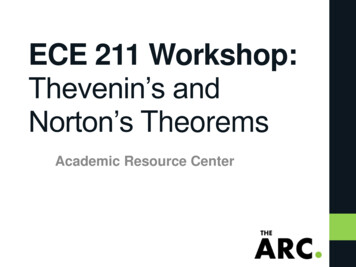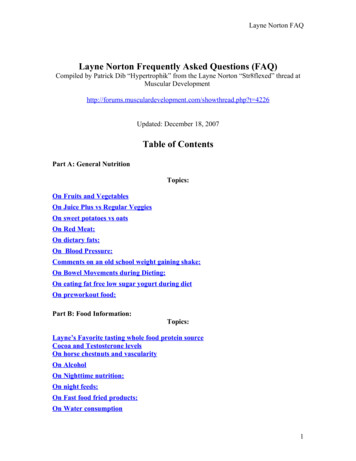
Transcription
ECE 211 Workshop:Thevenin’s andNorton’s TheoremsAcademic Resource Center
Agenda Background: Thevenin’s TheoremsReview Thevenin's AnalysisHow to find Equivalent Thevenin's VoltageSource and relating problemso How to find Equivalent Thevenin's Resistorand relating problemso Transformation between two Theorems Practice Problems and Solutions
Thevenin's Theorem ReviewGeneral Idea: In circuit theory, Thévenin's theorem for linearelectrical networks states that any combination of voltagesources, current sources, and resistors with two terminals iselectrically equivalent to a single voltage source V in serieswith a single series resistor R. Those sources mentionedabove can be either independent or dependent.
Thevenin's Theorem ReviewAnalyze Procedure:1.Calculate the output voltage, V, when in open circuitcondition (no load resistor—meaning infinite resistance).This is VTh.2.Calculate the output current, IAB, when the outputterminals are short circuited (load resistance is 0). RThequals VTh divided by this IAB.Step 2 could also be thought of as:2a. Replace voltage sources with short circuits(wires), andcurrent sources with open circuits(disconnections).2b. Calculate the resistance between terminals A and B. Thisis RTh.
Thevenin's Voltage Example Find equivalent voltagesource in new circuit Solution:Between terminals A and B, weneed to find out V. Since it'sopen circuit and there is nocurrent going through R1.TreatR1 as wire. ciucuit becomesimple three series resistor anda voltage source.Secondly, find the current.Thirdly, find the sum voltageacross R3 and R2. That's theanswer we're looking for.Using Ohm’s law, we find:I V/R, where V 15VR R4 R3 R2 4OhmI 15/4 3.75AOhm's law again,Vab 2*3.75 7.5V
Practice Problems 1A
Practice Problems 1BThere is only one path in the circuit, sothe ratio of the two resistors are theratio of their voltages(same current).V0 2V0(20K Ohms) 4V0 70VV0 10VTwo ways finding Vab:Vab 70V- V0 2V0 4V0 60V
Practice Problems 2A
Practice Problems 2BFirstly, if we perform the sourcetransformation, the original circuitchanges to a simple series one. Noticethe two source are in the oppositedirection.Vsigma 60V - 30V 30VRsigma 30 Ohm 60 Ohm 90 OhmIsigma Vsimga/Rsigma 1/3 AV12 V60 30V 1/3 * 60 30V 50V
Thevenin's Resistor Example A Find equivalent resistorin new circuit Solution:Original method: short terminalsA and B as shown in the picture.Find the current I going throughA to B. Rth can be found byR2,3 R2 R3 2 OhmV/I,where V is the voltage weR2,3,1 R2,3 R1 2/3 ohmget from last problem.Rsigma R1,2,3,4 R2,3,1 R4 8/3 ohmIsigma V1/Rsigma 45/8 AIAB Isigma * (R2 R3) / (R1 R2 R3) 15/4 ARth VAB/IAB 2 Ohm
Thevenin's Resistor Example B Find equivalent resistorin new circuit Solution:Alternatively method: leaveterminals A and B open,insteadof short Volage source V1,shown in the picture. Since nodependent source apprearing inthe graph, we just need to findRth by series and paralleltheory.R2,3 R2 R3 2 OhmR2,3,4 R2,3 R4 1 ohmRsigma R1,2,3,4 R2,3,4 R1 2 ohmWhich matches the previous results.
Thevenin's Example summary1 The graph shown in the righthand side gives the final resultfor Thevenin's theory.compared with original circuit,it looks a lot easier to furtheranalyze.2 Generally speaking, out of thetwo ways in findng equivalentresistor. A is more suitable forgraph containing denpendentsource. B is more useful in thesituation of simply paralleland series resistors.
Practice Problems 3A
Practice Problems 3BWhen we try to calculate the quivalentresistor, simply short indenpendetvoltage source and open independentcurrent source. Then, the lower leftcircuit is derived.R1 16 Ohm 4 Ohm 20 OhmR2 R1 5 Ohm 20 Ohm 5 Ohm 4 OhmRsigma R2 1 Ohm 5 Ohm
Practice Problems 4A
Practice Problems 4BShort indenpendet voltage source, thenyou have lower left circuit.In order to find out the equivalentresistor, we need an additionalindentpent source apply to terminnals aand b. Figure show lower.
Practice Problems 4BSince we assume the voltagesource has a value of 12V, we needone more parameter, currentI(through voltage source) to figureout resistance using equation R U/I.Assumption: current direction in 2Ohm is a to N. 6 Ohm and 3 Ohmshare the same voltage(V0). For nodeN, current going out are (V0/6 V0/3).Assumption: current direction in 2Ohm is a to N. Total current going in:(0.25v0 i). From KCL we equal (V0/6 V0/3) with (0.25v0 i), we get i v0/4.From KVL v0/4 * 2 v0 12 Vv0 8 VIab 0.25v0 v0/4(2 Ohm) 0.5 v0 4ARth Vab/Iab 12/4 3 Ohm
Norton's Theorem ReviewGeneral Idea: Norton's theorem for linear electrical networks,known in Europe as the Mayer–Norton theorem, states thatany collection of voltage sources, current sources, andresistors with two terminals is electrically equivalent to anideal current source, I, in parallel with a single resistor, R.Those sources mentioned above can also either bedependent or independent sources.Analyze Procedure: 1.Find the Norton current INo. Calculatethe output current, IAB, with a short circuit as the load(meaning 0 resistance between A and B). This is INo.2.Find the Norton resistance RNo. There are two methods ofdetermining the Norton impedance RNo. (the same asThevenin's Theorem)
Transformation between two methodsFrom the description we have seen at least two simiarities.Firstly, they both use load equaling to 0 finding current.Secondly, the way they finds quivalent resistors are preciselymatched. Thus we conclude that those two are essentiallythe same.Transformation eqation are:Rno RthVth Ino * RnoIno Vth / Rno
Practice Problems
Practice Problems
Solutions to Practice ProblemsVth: (original figure)1k * I0 2 Vx 3VVx 40I0 * 50solve the above:Vx Vth 1.2VI0 0.6 mAWe short the votage source andadd an additional votage sourcebetween a and b.(lower figure)Rth:So, we have: 1000 * I0 -2*VxVx 3Vsolve the above:I0 -6 mA-40 I0 - Vx/50 Iab 0.18Adirection: a to bRth 3V/ Iab -16.67 Ohm
Solutions to Practice ProblemsVth:(2i 0.5 Vx) *10 2i Vx(Vx/6 i) * 3 Vx 50solve the above:Vx 100V,i -33.3AVth (0.5 Vx i ) 166.67 VWe short the votage source andadd an additional votage sourcebetween a and b.Rth:So, we have:Vx/6 Vx/3 i 0Vx - 2i 50Vsolve the above:i -12.5A, Vx 25VIab -i - 0.5Vx 50V/10 5Adirection: b to aRth 50V/ Iab 10 Ohm
END!!
Norton's Theorem Review General Idea: Norton's theorem for linear electrical networks, known in Europe as the Mayer-Norton theorem, states that any collection of voltage sources, current sources, and resistors with two terminals is electrically equivalent to an ideal current source, I, in parallel with a single resistor, R.










